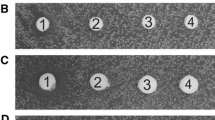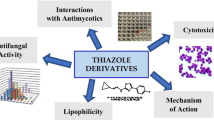Abstract
Novel oximes were synthesized, their in vitro antifungal activity against Candida was evaluated and their cytotoxicity was determined. The procedure used for the synthesis of the oximes is aligned with the current green chemistry trend; water is employed as the solvent in this reaction. The minimum inhibitory and minimum fungicidal concentrations of the oximes were evaluated using the CLSI M27-A3 method. The influence of these compounds on the inhibition of the production of hydrolytic enzymes, phospholipase and proteinase by Candida was also investigated. The compounds showed a good ability to inhibit phospholipase, with a 50 % reduction in most cases. However, the tested compounds did not affect proteinase. The current results showed a substantial reduction in the phospholipase production, which suggests that compounds of this class may interfere with host infection and disease progression. The oximes examined showed lower fungicidal activities than fluconazole but interfered significantly with the expression of phospholipase. Some of the oximes included in this study could be a suitable matrix for the development of novel antifungal compounds.

Similar content being viewed by others
References
Ramage GS, Milligan DF, Lappin L, et al. Antifungal, cytotoxic, and immunomodulatory properties of tea tree oil and its derivative components: potential role in management of oral candidosis in cancer patients. Front Microbiol. 2012;3:220–8.
Kanafani ZA, Perfect JR. Resistance to antifungal agents: mechanisms and clinical impact. Clin Infect Dis. 2008;46:120–8.
Cowen LE. The evolution of fungal drug resistance: modulating the trajectory from genotype to phenotype. Nat Rev Microbiol. 2008;6:187–98.
Stefani HA, Oliveira CB, Almeida RB, et al. Dihydropyrimidin-(2H)-ones obtained by ultrasound irradiation: a new class of potential antioxidant agents. Eur J Med Chem. 2012;41:513–8.
Vasconcelos A, Oliveira PS, Ritter M, et al. Antioxidant capacity and environmentally friendly synthesis of dihydropyrimidin-(2H)-ones promoted by naturally occurring organic acids. J Biochem Mol Toxicol. 2012;26:155–61.
Flores AFC, Pizzuti L, Piovesan LA, et al. Efficient synthesis of new 1-alkyl (aryl)-5-(3,3,3-trihalo-2-oxopropylidene)-1H-pyrrol-2(5H)-ones. Tetrahedron Lett. 2010;51:4908–10.
Silva FAN, Galluzzi MP, Albuquerque B, et al. Ultrasound irradiation promoted large-scale preparation in aqueous media and antioxidant activity of azoles. Lett Drug Des Discov. 2009;6:323–6.
Silva FAN, Pizzuti L, Quina FH, et al. Antioxidant capacity of 2-(3,5-diaryl-4,5-dihydro-1H-pyrazol-1-yl)-4-phenylthiazoles. Lett Drug Des Discov. 2010;7:657–60.
Prushan MJ, Addison AW, Butcher RJ. Pentadentate thioether-oxime macrocyclic and quasi-macrocyclic complexes of copper (II) and nickel (II). Inorg Chim Acta. 2000;300:992–1003.
Karatas I, Uçan HI. The synthesis of biphenylglyoxime and bis(henylglyoxime) and their complexes with Cu(II), Ni(II) and Co(II). Synth React Inorg Met Org Chem. 1998;28:383.
Canpolat E, Kaya M. Synthesis and formation of a new vic-dioxime complexes. J Coord Chem. 2005;58:1217.
Sikharulidze MI, Nadaraia NSh, Kakhabrishvili ML, et al. Synthesis and biological activity of several steroidal oximes. Chem Nat Compd. 2010;46:494–5.
Li J-T, Li X-L, Li T-S. Synthesis of oximes under ultrasound irradiation. Ultrason Sonochem. 2006;13:200.
Kadir T, Gümrü B, Uygun-Can B. Phospholipase activity of Candida albicans isolates from patients with denture stomatitis: the influence of chlorhexidine gluconate on phospholipase production. Arch Oral Biol. 2007;52:691–6.
Naglik JR, Challacombe SJ, Hube B. Candida albicans secreted aspartyl proteinases in virulence and pathogenesis. Microbiol Mol Biol Rev. 2003;6:400–28.
Willis AM, Coulter WA, Fulton CR, et al. The influence of antifungal drugs on virulence properties of Candida albicans in patients with diabetes mellitus. Oral Surg Oral Med Oral Pathol Oral Radiol Endod. 2001;91:317–21.
Fonzi WA. The protein secretory pathway of Candida albicans. Mycoses. 2009;52:291–303.
Abaci O. Investigation of extracellular phospholipase and proteinase activities of Candida species isolated from individuals denture wearers and genotypic distribution of Candida albicans strains. Curr Microbiol. 2011;62:1308–14.
Barros LM, Boriollo MF, Alves AC, et al. Genetic diversity and exoenzyme activities of Candida albicans and Candida dubliniensis isolated from the oral cavity of Brazilian periodontal patients. Arch Oral Biol. 2008;53:1172–8.
Wu T, Wright K, Hurst SF, et al. Enhanced extracellular production of aspartyl proteinase, a virulence factor, by Candida albicans isolates following growth in sub-inhibitory concentrations of fluconazole. Antimicrob Agents Chemother. 2000;44:1200–8.
Anil S, Samaranayake LP. Brief exposure to antimycotics reduces the extracellular phospholipase activity of Candida albicans and Candida tropicalis. Chemotherapy. 2003;49:243–7.
Khoramabadi-Zad A, Azadmanesh M, Rezaee A. Simple efficient and green synthesis of oximes under ultrasound irradiation. S Afr J Chem. 2010;63:192.
Clinical laboratory standards institution. Reference method for broth dilution antifungal susceptibility testing of yeasts. Approved standard CLSI document M27-A3. Wayne, PA.; 2008.
Duval AR, Carvalho PH, Soares MC, et al. 7-Chloroquinolin-4-yl arylhydrazone derivatives: synthesis and antifungal activity. Sci World J. 2011;11:1489–95.
Nedel F, Begnini K, Carvalho PH, et al. Antiproliferative activity of flower hexane extract obtained from Mentha spicata associated with Mentha rotundifolia against the MCF7, KB, and NIH/3T3 cell lines. J Med Food. 2012;15:955–8.
Henn S, Nedel F, de Carvalho RV, et al. Characterization of an antimicrobial dental resin adhesive containing zinc methacrylate. J Mater Sci Mater Med. 2011;22:1797–802.
Nedel F, Campos VF, Alves D, et al. Substituted diaryl diselenides: cytotoxic and apoptotic effect in human colon adenocarcinoma cells. Life Sci. 2012;91:345–52.
Kumar CPG, Kumar SSJ, Menon T. Phospholipase and proteinase activities of clinical isolates of Candida from immunocompromised patients. Mycopathologia. 2006;161:213–8.
Haynes K. Review: virulence in Candida species. Trends Microbiol. 2009;9:591–7.
Gokce G, Cerikcioglu N, Yagci A. Acid proteinase, phospholipase, and biofilm production of Candida species isolated from blood cultures. Mycopathologia. 2007;164:265–9.
Ibrahim AS, Mirbod F, Filler SG, et al. Evidence implicating phospholipase as a virulence factor of Candida albicans. Infect Immun. 1995;63:1993–8.
Acknowledgments
The current research was funded by CNPq, CAPES and UFPel.
Author information
Authors and Affiliations
Corresponding author
Rights and permissions
About this article
Cite this article
Souza, J.L.S., Nedel, F., Ritter, M. et al. Antifungal Susceptibility, Exoenzyme Production and Cytotoxicity of Novel Oximes against Candida . Mycopathologia 176, 201–210 (2013). https://doi.org/10.1007/s11046-013-9675-7
Received:
Accepted:
Published:
Issue Date:
DOI: https://doi.org/10.1007/s11046-013-9675-7




